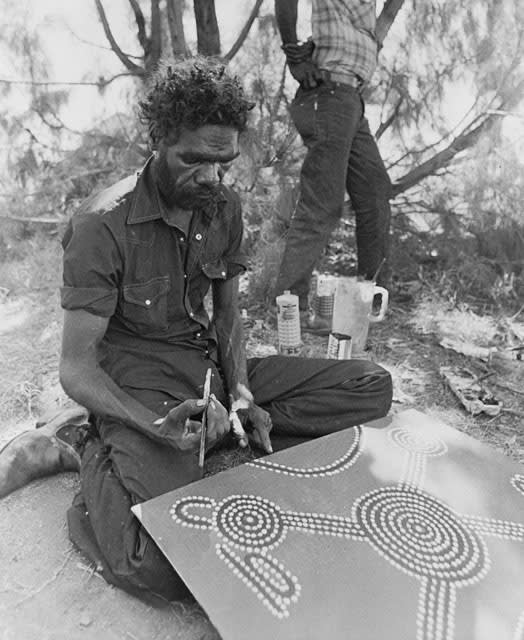Turkey Tolsen Tjupurrula 1942-2001
Turkey Tolson Tjupurrula (b. 1942 - 2001) holds a historic place in the story of contemporary Aboriginal art. He was part of the first of a slightly younger generation of Desert Painters who began painting at Papunya in 1973, transposing ancient iconographies and traditional designs onto board and canvas. His pictures, iconic examples of the ‘dot-and-circle’ school, record the landscape and its creation with a mesmerising spiritual intensity.
He had observed the work of older men, including Mick Namarari Tjapaltjarri, George Maxwell Tjangala and Ray Inkamala Tjampitjinpa, before picking up the brush himself. By the late 1970s he had developed into an accomplished artist in his own right and, because of his understanding of non-Aboriginal people and his command of English, was in a good position to be an effective cultural broker for his older relatives.
Tolson was born just outside Ikuntji (Haasts Bluff), soon after his Pintupi-speaking family had migrated east out of the Gibson Desert. As a young man he honed his bush skills, trapping dingoes around the western MacDonnell Ranges with his father. In the 1970s and early 1980s, Tolson spent his time alternately in Papunya and at the outstation, Kungkayurnti. In 1985 he moved west to Walungurru (Kintore), which is just to the north of his ancestral country. He soon established an out-station at Yuwalki, along the route of the Kungka Kutjarra (Two Ancestral Women) that he depicts so often in his paintings.
Tolson’s work developed through a succession of styles. His earlier, smaller works were modest, and conformed to the accepted conventions of the Pintupi artists. By the late 1970s, however, he had completed several large canvases in which the application of concentric circles and dotted bands was expressed to create an effect of mesmerising perfection. The 1980s was a period of visual exploration for the artist, his technical expertise allowing him to create subtle tonal effects combined with bold iconographic elements.
In 1990, Tolson painted Straightening the spears at Ilyingaunga – this work, now in the Art Gallery of South Australia, Adelaide, heralded in a new phase of minimalism in Papunya Tula art. Through-out the next decade he would occasionally represent the same site, using arbitrary variations of his dotted line to echo the irregularities of thin mulyati (acacia species) spears. Living at Yuwalki, Tolson regularly visited the small claypan, Ilyingaungau, or the cave site, Mitukatjirri, from where the ancestral warriors had travelled.
The artist quickly distinguished himself as one of the most innovative artists of the Papaunya Tula movement. While his early works explored traditional Tingari imagery, he ventured towards more painterly works during the 1980s, coupling narrative and geographic iconography with an accentuated focus on the intersection of line and colour. His command of seemingly abstract form allowed him to convey the vibrant presence of the living desert along with its mysterious underlay of ancestral power.
The art world responded enthusiastically to Tolson's artistic versatility and desire to experiment. He travelled to Paris with Joseph Jurra Tjapaltjarri to create a sand painting as part of the 'Peintres Aborigines d'Australie' exhbiition in 1987 and participated in international artists residencies away from the early1990s. In his role as the Chairman of Papunya Tula Artists (1985-95) he proved an effective intermediary between many of the older artists and non-indigenous art buyers and writers at the time. His work is held in significant collections around the world, including the Art Gallery of New South Wales, Canberra, and the National Gallery of Victoria, Melbourne. His paintings were invariably included in landmark exhibitions from the early 1980s. These included the exhibition of works from the Richard Kelton collection, Contemporary Australian Art 1981 at the Pacific Asia Museum in Los Angeles, The Face of the Centre at the National Gallery of Victoria in 1985, Aratjara: Art of the First Australians which toured Germany and the UK in 1993-1994 and Papunya Tula: Genesis and Genius at the Art Gallery of NSW in 2000. His prints were included in the comprehensive survey of Aboriginal printmaking New Tracks, Old Land, which was shown to international acclaim in America, touring 25 venues throughout Australia in the early 1990s.



